

Dangerous Animals. Choosing a Survival Dog. Since the dawn of time, man and dog have had an unbreakable relationship.
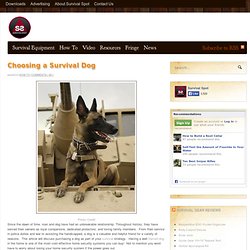
Throughout history, they have served their owners as loyal companions, dedicated protectors, and loving family members. From their service in police duties and war to assisting the handicapped, a dog is a valuable and helpful friend for a variety of reasons. This article will discuss purchasing a dog as part of your survival strategy. Having a well trained dog in the home is one of the most cost-effective home security systems you can buy! Not to mention you wont have to worry about losing your home security system if the power goes out.
Choosing A Breed. Survival Debate: Dog or No Dog. Deciding whether or not to take your dog in a survival situation is a more difficult question than choosing between types of gear.

For animal loving pet owners it’s a no-brainer. Others might see dogs an an unnecessary risk and use of supplies. The dogs of the Inuit: companions in survival. Implements used for dog team travel Traditional and contemporary use of the Inuit dog Nutrition General health and veterinary care The team Tourism and economic development Bibliography L.

Peplinski Lynn Peplinski is the Manager of the Iqaluit Research Centre, Science Institute of the Nonthwest Territories, PO Box 1198, Iqaluit, Northwest Territories, Canada X0A 0H0. Acknowledgements K. Breeding Rabbits: All about rabbits breeding, conception to weaning. Breeding Rabbits.
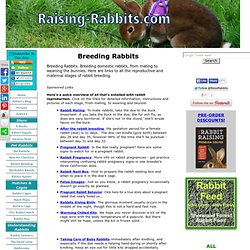
Breeding domestic rabbits, from mating to weaning the bunnies. Raising Rabbits. Benefits Of Rabbits Raising rabbits are much cheaper, more efficient, and more productive than raising chickens. 1) A doe can produce up to 1000% her body weight in food per year. 2) Rabbits can be raised in confinement, whereas chickens need much more space. 3) Chicken reproduction is "light sensitive", whereas rabbit reproduction is opportunity sensitive. 4) It is much easier to raise food for rabbits than it is food for chickens. 5) Since rabbits are raised in confinement, it drastically reduces the threat to your herd from predators. 6) You can skin and butcher 5 rabbits to every chicken given the same amount of time. 7) Rabbit fur can be a separate barter item.

Rabbit meat tastes good too, some people say that it taste much like poultry. Rabbit meat is mild and savory, never gamy. It is extremely lean, making it perfect for cholesterol-reducing diets. Besides providing you with meat, rabbits produce dung, which makes a good fertilizer. Breeding Rabbits - Do's and Don'ts When You Breed Rabbits.
The Complete Beginners Guide To Raising Sheep. Sheep Care - How To Information. How to Get Started in Raising Sheep: 12 steps. Edit Article Edited by ElizaNado, Nicole Willson, Martyn P, Travis Derouin and 19 others.
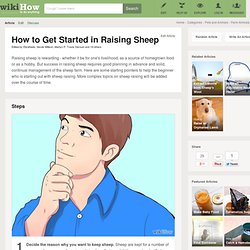
Sheep husbandry. Mediaeval Sheep byre in a natural cave in northern Spain.
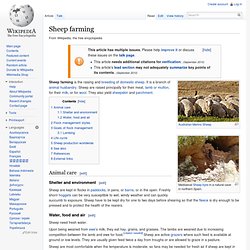
Sheep farming is the raising and breeding of domestic sheep. It is a branch of animal husbandry. Sheep are raised principally for their meat, lamb or mutton, for their milk, or for wool. They also yield sheepskin and parchment. List of sheep breeds. Sheep 201: Breed Selection. Selecting a breed of sheep According to some estimates, there are more than 1,000 breeds of sheep worldwide and more than 50 in the United States.
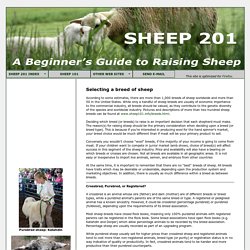
While only a handful of sheep breeds are usually of economic importance to the commercial industry, all breeds should be valued, as they contribute to the genetic diversity of the species and worldwide industry. Pictures and descriptions of more than two hundred sheep breeds can be found at www.sheep101.info/breeds.html. Raising Pigs for Meat - 5 Things To Consider If You Are Thinking of Rearing Pigs for Meat. The Different Breeds of Pig. Pig Care Sheet. But, again, pigs do not like being in the mud 24 hours a day.

If fresh straw is put in their house (which it should be) they keep their house very clean, they do not urinate or defecate in their house. So straw in their house will last quite a while. In fact, pigs prefer to sleep on clean dry straw at night. I get upset when I see people putting pigs in dirty muddy houses, Pigs DO NOT like this.. Pigs do root a lot, this is why it is best to keep them by themselves and not mix them with horses, cows or any other animal. They never really had a mud hole in their pen. List of horse breeds. Light or saddle horse breeds Heavy or draft horse breeds.
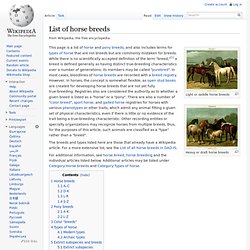
How to Raise Horses: Everything You Need to Know by Daniel Johnson. Synopses & Reviews Whether it’s a friendly riding companion or a show horse, the expert advice in this hands-on guidebook provides all the information you’ll need, including health care, housing, feed requirements, and raising foals. An essential primer for the newcomer to horse care, as well as an invaluable resource for the veteran, this guide includes more than 200 color photos and covers all the basics such as the finer points of choosing the right breed, how to purchase a horse, boarding and housing needs, breeding, and training. Easy-to-follow advice helps you to: · Choose a breed and purchase a horse. Horse care. Living environment[edit] Raising Horses. Beekeeping. Beekeeping in Serbia Beekeeping (or apiculture, from Latin: apis "bee") is the maintenance of honey bee colonies, commonly in hives, by humans. A beekeeper (or apiarist) keeps bees in order to collect their honey and other products that the hive produces (including beeswax, propolis, pollen, and royal jelly), to pollinate crops, or to produce bees for sale to other beekeepers.
Pender Beekeeping Supplies - for quality beekeeping equipment. Beekeeping Success. Beekeeping: The Beekeeper's Home Page. Raising Chickens: Real People With Real Chicken Experience. How To Raise Chickens. Raising chickens can be exciting and interesting, when armed with the required knowledge. This is a simplified view of the steps to raise chickens. Acquiring Stock There are two choices when raising chickens; buying full grown birds or buying chicks. Full Grown: They are easy to raise, but the vaccination records should be checked and the birds should be free from disease. Their egg laying capacity should be confirmed, if they are being bought for layers.
List of chicken breeds. Twenty-nine varieties of chicken (and one Guinea Fowl). There are hundreds of chicken breeds in existence.[1] Domesticated for thousands of years, distinguishable breeds of chicken have been present since the combined factors of geographical isolation and selection for desired characteristics created regional types with distinct physical and behavioral traits passed on to their offspring.[2] By place of origin[edit] Afghanistan[edit] Albania[edit] Australia[edit]
Raising ducks and geese on pasture by Steve Edwards from the January/February, 2008 issue of Countryside & Small Stock Journal. The term “pastured poultry” usually brings to mind some type of free-range chicken enterprise. Chickens can be free-ranged for meat or egg production. Pastured poultry models utilize the now famous “chicken tractor” (with variations thereof), the Joel Salatin style “eggmobile” or simply turning the birds out on old-fashioned pasture.
Pasturing poultry is nothing new. In fact, it’s a reversion to the original way birds were raised. How To Raise Ducks And Geese Organically For Meat And Eggs. Waterfowl are wonderful birds to have in a home flock. List of duck breeds. List of duck breeds From Wikipedia, the free encyclopedia. List of goose breeds. Goose breeds are usually grouped into 3 weight classes: Heavy, Medium and Light. List of goat breeds. How to Care for Goats. The Beginners Guide To Raising Goats. Raising cattle on your own place by Charles Sanders. Winter won't last forever. It won't be long before spring will arrive and pastures will start to green up. This may be the year for you to consider raising a few head of beef cattle. Traditionally, once Spring springs, cattle prices begin to do the same. As pastures green up, it seems like everyone is looking for calves and feeders to put on grass. How to Care for Cattle. Raising Dairy Cattle. Self-Sufficiency in Style. Animal Farm. Cattle for Meat.
The Dairy Site - Breeds - Dairy. Dairy cattle. A Holstein cow with prominent udder and less muscle than is typical of beef breeds Dairy cattle (also called dairy cows or milk cows) are cattle cows bred for the ability to produce large quantities of milk, from which dairy products are made. Dairy cows generally are of the species Bos taurus.[1] Historically, there was little distinction between dairy cattle and beef cattle, with the same stock often being used for both meat and milk production.
Today, the bovine industry is more specialized and most dairy cattle have been bred to produce large volumes of milk. The United States dairy herd produced 83.9 billion kg (185 billion lbs) of milk in 2007, up from 52.6 billion kg (116 billion lbs) in 1950.,[2][3] Yet there are more than 9 million cows on U.S. dairy farms—about 13 million fewer than there were in 1950.[3] Management[edit] Cows on a dairy farm in Maryland, U.S.
To maintain lactation, a dairy cow must be bred and produce calves. List of cattle breeds. The Cattle Site - Breeds - Beef.